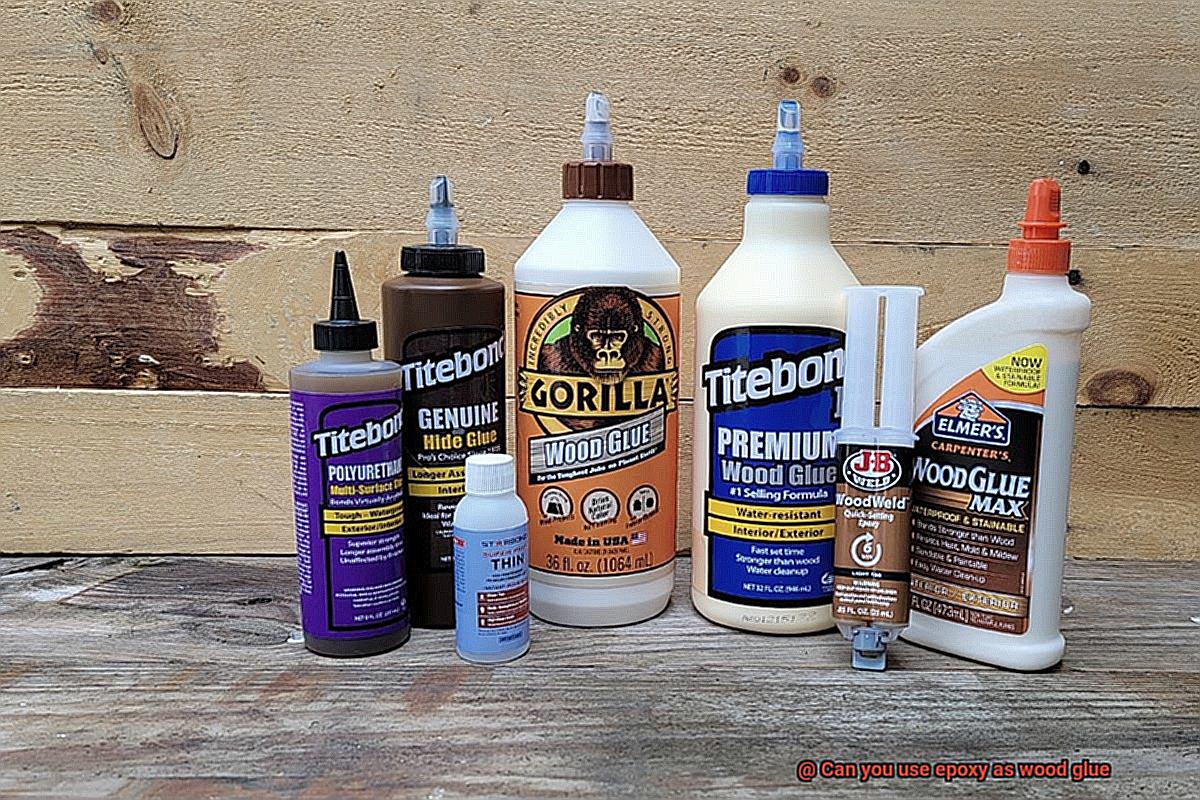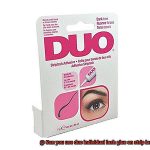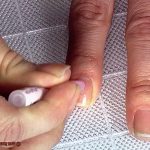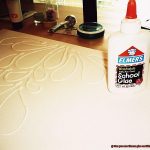Woodworking is a craft that demands precision, skill, and patience. Whether you’re a DIY enthusiast or a seasoned professional, having the right tools and materials can make all the difference in the quality of your finished products. But with so many glues available on the market, it’s hard to know which one to choose. So, have you ever considered using epoxy as a wood glue?
Epoxy has been gaining popularity in various industries, including woodworking, thanks to its unique properties. It’s an adhesive that can bond different types of materials together, including wood. Epoxy creates a strong, durable bond that can withstand even the toughest of applications.
However, before you jump into using epoxy as a wood glue, it’s essential to understand how it works and what makes it different from traditional wood adhesives. In this blog post, we’ll explore everything you need to know about using epoxy as a wood glue. From its benefits and limitations to when and how to use it, we’ll cover all the essential aspects to help you make an informed decision.
So, if you’re curious about whether epoxy can replace traditional wood glue in your next woodworking project – keep reading. We’ve got all the information you need right here.
What is Epoxy?
Contents
- 1 What is Epoxy?
- 2 Types of Wood Suitable for Epoxy Bonding
- 3 Application Process for Epoxy Bonding
- 4 Advantages and Disadvantages of Using Epoxy as Wood Glue
- 5 Factors to Consider Before Choosing Epoxy as Wood Glue
- 6 Tips for Working with Epoxy as Wood Glue
- 7 Common Mistakes When Using Epoxy as Wood Glue
- 8 Alternatives to Using Epoxy as Wood Glue
- 9 Conclusion
Epoxy is more than just a simple adhesive. It’s a powerful two-part bonding solution that has become a go-to product for construction, automotive, and even artistic applications. At its core, epoxy consists of a resin and a hardener that undergo a chemical reaction when mixed together. This results in a bond that is strong, durable, and resistant to various elements.
One of the most remarkable properties of epoxy is its versatility. It can bond to an expansive range of materials, from wood and metal to glass and plastic. Its ability to adapt to different surfaces makes it an ideal choice for many different applications.
Epoxy’s strength and durability also make it an excellent choice for use in environments where exposure to water, chemicals, and heat is common. It can withstand harsh conditions without weakening or breaking down over time.
When it comes to using epoxy as wood glue, however, there are important considerations to keep in mind. The type of wood being bonded plays a significant role in the effectiveness of the bond. Hardwoods like oak and maple can be successfully bonded with epoxy, while softwoods like pine or cedar may not be as suitable due to their tendency to absorb the adhesive.
The application process for epoxy also requires precision and accuracy. A perfect mix of resin and hardener is necessary for the adhesive to work correctly. This means that large or complex projects may not be ideal for epoxy as a bonding solution.
Types of Wood Suitable for Epoxy Bonding
When it comes to woodworking, one of the most important factors to consider is the type of wood that is suitable for epoxy bonding. Not all woods are created equal, and selecting the wrong type of wood can result in a weak bond or even complete failure of the joint. To help you make an informed decision, we’ve compiled a list of wood types that are suitable for epoxy bonding.
Teak
This dense and oily hardwood is commonly used in boat building due to its exceptional resistance to water and rot. Its tight and consistent grain pattern ensures that epoxy penetrates evenly, creating a strong bond that will last for years.
Mahogany
Known for its strength, durability, and good rot resistance, mahogany has a tight and consistent grain pattern that makes it easy to work with when using epoxy as wood glue. It’s an excellent choice for furniture making and boat building.
Douglas Fir
This strong and durable softwood is often used in construction and works well with epoxy. It’s a popular choice for laminated beams and other structural elements due to its strength and ability to hold up under pressure.
Oak
Oak is a hardwood that is known for its strength and durability. It’s an excellent choice for epoxy bonding because it doesn’t shrink or swell much with changes in humidity, ensuring a long-lasting bond that won’t fail over time.
Cedar
This lightweight and aromatic softwood is often used for outdoor furniture and siding due to its good weather resistance. It works well with epoxy and has a tight grain pattern that ensures an even application of the adhesive.
However, it’s important to note that not all woods are suitable for epoxy bonding. Woods high in oil content, such as rosewood and cocobolo, can be challenging to bond with epoxy due to the oil interfering with the adhesive properties of the glue. Woods high in tannins, such as oak and walnut, can also pose challenges because the tannins can react with the hardener in the epoxy and cause discoloration.
To ensure compatibility between the wood and epoxy adhesive, it’s best to test a small area before starting your project. Follow manufacturer instructions carefully when using epoxy as wood glue to ensure a strong, durable bond that will stand up over time.
Application Process for Epoxy Bonding
When it comes to bonding wood surfaces together, epoxy can be a fantastic option. However, the application process is critical to ensuring a reliable, long-lasting bond. Here are some tips for getting it right.
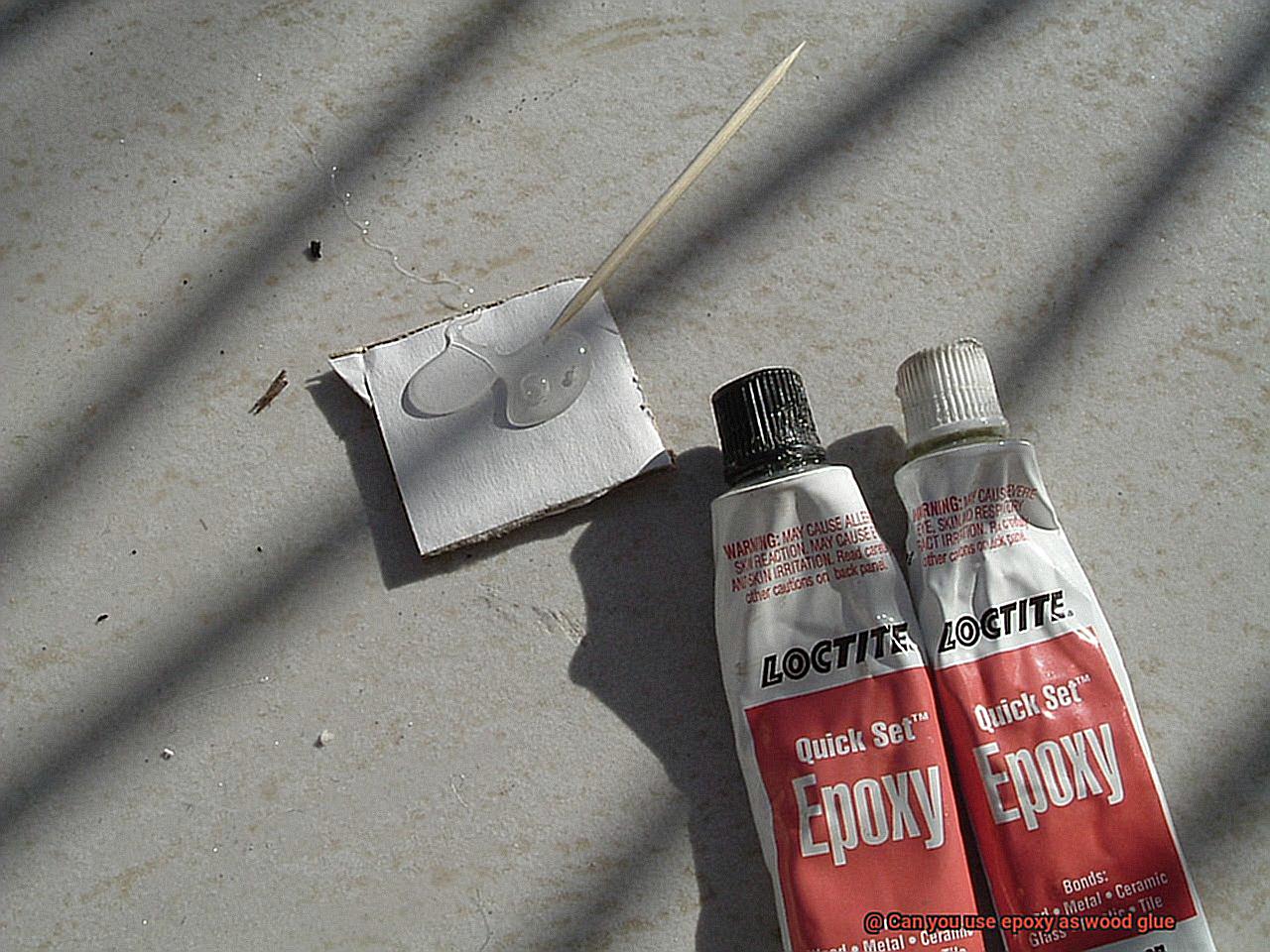
First, make sure your surfaces are clean and free from contaminants like dust, grease, or oil. Use a clean cloth or solvent to remove any stubborn debris.
Next, mix the epoxy adhesive according to the manufacturer’s instructions. This usually involves blending equal parts of resin and hardener until they are thoroughly combined. Be sure to follow the instructions carefully as different products may have different mixing ratios and curing times.
Now it’s time to apply the adhesive. Use a brush or spatula to spread the epoxy evenly and thinly over one of the surfaces you’ll be bonding. If needed, you can use clamps or weights to hold the surfaces together while the adhesive cures. But be patient – epoxy adhesives can take several hours to fully cure, and in some cases may require heat or pressure for optimal bonding strength.
It’s worth noting that not all wood types will bond well with epoxy. Teak, mahogany, Douglas fir, oak, and cedar are all excellent options due to their consistent grain patterns and resistance to water and rot. Woods high in oil content or tannins may pose more of a challenge and require testing before use.
Advantages and Disadvantages of Using Epoxy as Wood Glue
When it comes to woodworking, choosing the right adhesive can make or break your project. Epoxy is a popular option that boasts excellent bonding strength and durability. However, it’s crucial to understand the advantages and disadvantages of using epoxy as wood glue before diving in.
Let’s start with the advantages of using epoxy. Firstly, it creates an incredibly strong bond that can withstand significant stress, making it ideal for heavy-duty woodworking projects. Secondly, epoxy is waterproof and can resist moisture, making it perfect for outdoor applications or situations where the wood may come into contact with water. Thirdly, epoxy is a versatile adhesive that can bond with a wide range of materials, including wood, metal, plastic, and glass. Finally, epoxy is known for its durability and can last for many years without losing its bonding strength.
While epoxy has many benefits, there are also some drawbacks to consider. Firstly, it can be toxic if not handled correctly. Epoxy contains harmful chemicals that can cause skin irritation and respiratory problems if inhaled. Secondly, precise mixing and application are required when working with epoxy, which can be challenging for novice woodworkers. Thirdly, once mixed, epoxy hardens quickly, leaving little time for adjustments or corrections to the bond. Finally, epoxy can be more expensive than other wood glues on the market – something to consider if you’re working on small or simple projects.
Factors to Consider Before Choosing Epoxy as Wood Glue
Before diving in, it’s crucial to understand the factors that can make or break your project. As an expert in this field, I have compiled some research notes to help you make an informed decision before choosing epoxy as a wood glue.
First and foremost, let’s talk about the properties of epoxy. Epoxy is a two-part adhesive consisting of resin and hardener. When mixed together, they form a strong and durable bond that can withstand high stress and strain. However, the type of wood you’re working with is a crucial factor to consider. Epoxy works well with dense woods such as oak, teak, and mahogany but may not be suitable for softer woods like pine or cedar. Softwoods tend to absorb more moisture than hardwoods, leading to possible epoxy failure over time.
Next up is the application method. Epoxy can be applied in various ways, including brushing, pouring, or injecting. However, it’s essential to ensure an even distribution of the adhesive without any air pockets or voids in the bond. Using clamps or other pressure-applying tools can achieve this.
Moreover, it’s necessary to consider the working time and cure time of the epoxy. Working time refers to the period available to apply and adjust the adhesive before it begins to harden. On the other hand, cure time refers to the duration required for the adhesive to set fully and reach its maximum strength. It’s vital to select an epoxy with a working time and cure time that fits your project’s requirements.
Lastly, safety precautions are crucial while working with epoxy. Inhaling epoxy fumes can be harmful, so proper ventilation and protective gear should be used. Additionally, skin contact with uncured epoxy can cause irritation or allergic reactions; thus, gloves should always be worn.
Tips for Working with Epoxy as Wood Glue
When it comes to working with epoxy as wood glue, there are several important tips to keep in mind. These tips can help you achieve a strong and reliable bond between wood pieces that will stand up to heavy use and wear.
The first and perhaps most crucial tip is to properly prepare the surfaces that will be bonded together. This means making sure they are clean and free of any dirt, debris, or old adhesive residue. It’s also important to make sure they are completely dry before applying the epoxy.
Next, be sure to mix the epoxy according to the manufacturer’s instructions. This usually involves combining equal parts of resin and hardener and stirring thoroughly for a certain amount of time. Following the instructions carefully will help ensure that the epoxy sets and cures properly.
When applying the epoxy, it’s best to use a disposable brush or spreader to ensure even coverage. Be sure to apply it in a thin, even layer rather than using too much at once. This will prevent excess drips and run-off while allowing for better penetration into the wood fibers.
Clamping the wood pieces together tightly while the epoxy cures is also crucial for achieving a strong bond. The pressure from the clamp helps push the wood fibers together, creating a tighter bond between them.
Finally, it’s important to take any necessary safety precautions when working with epoxy as it can be toxic if ingested or inhaled. Wear gloves and work in a well-ventilated area to avoid any potential health risks.
Common Mistakes When Using Epoxy as Wood Glue
As someone who’s familiar with the ins and outs of using epoxy as wood glue, I want to share some tips on how to avoid common mistakes that can weaken the bond between your wood pieces. Let’s get started.
First and foremost, one of the biggest mistakes people make is not properly preparing the surface before applying epoxy. Skipping this step can lead to a weak bond, as dust and debris can prevent the epoxy from adhering properly. Make sure to clean the surface thoroughly and ensure it’s dry before applying epoxy.
Another common mistake is using too much or too little epoxy. This can lead to a messy application or a lack of adhesive, respectively. To avoid this, follow the recommended amount of epoxy for your project.
Not allowing enough time for the epoxy to cure is another pitfall. Epoxy needs time to fully cure and harden, so rushing the process can result in a weak bond. It’s important to follow the manufacturer’s instructions and give the epoxy enough time to cure before handling or using the bonded wood.
Last but not least, using the wrong type of epoxy can also be problematic. Different types of epoxies have unique properties and uses, so choosing the wrong one can result in a weak bond or even damage to the wood. Take some time to research which type of epoxy is best suited for your project.
Alternatives to Using Epoxy as Wood Glue
When it comes to woodworking, choosing the right adhesive is crucial to ensure your project is strong and durable. While epoxy is a reliable option, it’s always good to expand your horizons and try something new. That’s why we’ve compiled a list of alternative wood glues that are worth considering for your next project.
First up is polyurethane glue, which expands as it dries, filling in gaps and voids in the wood. This makes it perfect for uneven surfaces and porous materials. Not only that, but it’s also water-resistant and ideal for both indoor and outdoor projects.
Next on the list is cyanoacrylate glue, also known as super glue. Although not as robust as epoxy or polyurethane glue, it dries quickly and can be useful for smaller repairs or bonding non-porous materials like metal or plastic to wood.
For those looking for a natural adhesive option, hide glue may be just what you need. Made from animal hides, it’s been used in woodworking for centuries. Hide glue is reversible and non-toxic, making it perfect for food-grade projects like cutting boards.
Lastly, there’s white glue or PVA glue. While commonly used in school projects and crafting, it can also be an effective wood adhesive. It dries clear and can be sanded or painted over once dry. However, it may not hold up well under stress or moisture.
Conclusion
In conclusion, epoxy is a versatile adhesive that can be used as wood glue in a variety of woodworking projects. Its exceptional strength and durability make it an excellent choice for heavy-duty applications, while its waterproof properties make it ideal for outdoor use. However, it’s crucial to understand the limitations of epoxy as a wood glue, including its compatibility with certain types of wood and the need for precise application.
When considering using epoxy as a wood glue, it’s essential to choose the right type of wood and carefully follow the manufacturer’s instructions. Teak, mahogany, Douglas fir, oak, and cedar are all suitable options due to their consistent grain patterns and resistance to water and rot.
While epoxy boasts many advantages over traditional wood glues, there are also some drawbacks to consider. It can be toxic if not handled correctly and requires precise mixing and application techniques. Additionally, epoxy can be more expensive than other adhesives on the market.
Ultimately, choosing the right adhesive depends on your project’s specific requirements. Polyurethane glue, cyanoacrylate glue, hide glue, and white or PVA glue are all alternative options worth considering based on your needs.

